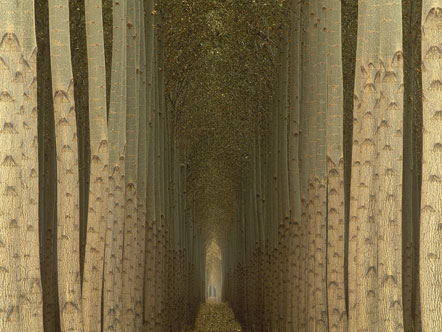Tag: nature
Local Art @ EPL: Delores Rix
September 5, 2017
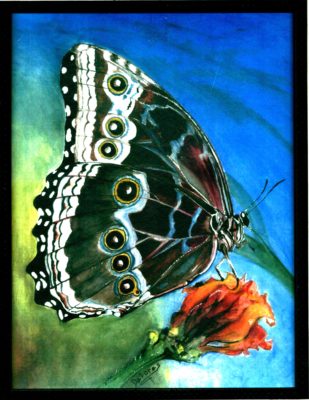 We are excited to welcome Delores Rix as the next featured artist in our ongoing exhibition series Local Art @ EPL. She began to pursue her artistic dreams in 2005, and since then her wonderfully-detailed watercolors depicting flowers, cats, butterflies, and her travels have shown throughout Chicagoland including at Le Peep, Fireside Restaurant, the Roscoe Village Starbucks, and Mayor Daley’s Chicago Senior Fest at McCormick Place. You can catch her show through the end of September on the 2nd floor of EPL’s Main Library and meet her at a closing reception on Thursday, September 28 from 6-8 pm. Don’t miss the work of this talented local artist!
We are excited to welcome Delores Rix as the next featured artist in our ongoing exhibition series Local Art @ EPL. She began to pursue her artistic dreams in 2005, and since then her wonderfully-detailed watercolors depicting flowers, cats, butterflies, and her travels have shown throughout Chicagoland including at Le Peep, Fireside Restaurant, the Roscoe Village Starbucks, and Mayor Daley’s Chicago Senior Fest at McCormick Place. You can catch her show through the end of September on the 2nd floor of EPL’s Main Library and meet her at a closing reception on Thursday, September 28 from 6-8 pm. Don’t miss the work of this talented local artist!
An Interview with Lloyd Davidson
September 15, 2016
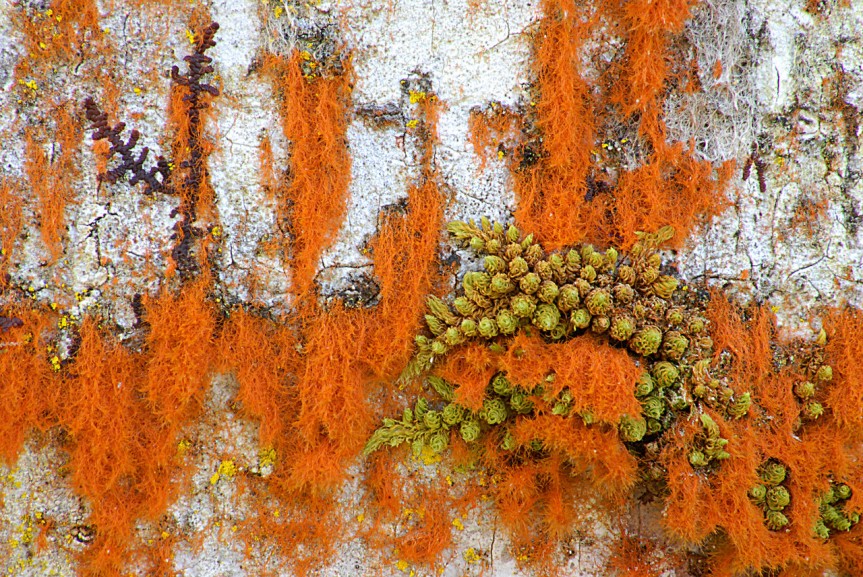
Lloyd Davidson is an Evanston photographer who made his Local Art @ EPL debut back in 2015. Now the retired NU Life Sciences Librarian has returned with a fresh collection of breathtaking nature photography captured everywhere from New Zealand to the American Southwest to James Park. You can catch this inspired show on the 2nd floor of EPL’s Main Library through the end of September, and you can view more of Dr. Davidson’s work by visiting his online gallery. Recently we spoke with him via email about his artistic inspirations including Kafka, Picasso, and Edward Weston, his three simple rules for capturing the perfect shot, the Louis Pasteur quote that is his motto, and the rich Evanston art scene.
Local Art @ EPL: Lloyd Davidson
September 2, 2016

We are thrilled to welcome Lloyd Davidson back to the library for a brand-new Local Art @ EPL exhibit. After making his 2015 library debut, the retired NU Life Sciences Librarian and Evanston photographer has returned with a fresh collection of breathtaking nature photography captured everywhere from New Zealand to the American Southwest to James Park. You can catch this inspired show on the 2nd floor of EPL’s Main Library through the end of September, and you can meet Dr. Davidson at an opening reception on September 8th at 7 pm. Also, make sure to check back with Off the Shelf later in the month for a featured interview with the artist himself. Stay tuned.
Local Art @ EPL
September 8, 2015
 We are pleased to introduce retired NU Life Sciences Librarian and photographer Lloyd Davidson as the next featured artist in our ongoing exhibition series Local Art @ EPL. His show is currently on display on the 2nd floor of EPL’s Main Library where you can catch it through September 30th. Informed by his M.A. in paleontology and Ph.D. in cell biology, Davidson’s breathtaking landscape, plant, and macro photographs reflect his engaged respect for the wilds of Alaska, Africa, Australia, and the American Southwest. You can meet Dr. Davidson at an opening reception this Tuesday, September 8th at 7 pm and also on Wednesday, September 23 at 7 pm when he will share photos and discuss the art of nature photography in our Community Meeting Room. Stay tuned.
We are pleased to introduce retired NU Life Sciences Librarian and photographer Lloyd Davidson as the next featured artist in our ongoing exhibition series Local Art @ EPL. His show is currently on display on the 2nd floor of EPL’s Main Library where you can catch it through September 30th. Informed by his M.A. in paleontology and Ph.D. in cell biology, Davidson’s breathtaking landscape, plant, and macro photographs reflect his engaged respect for the wilds of Alaska, Africa, Australia, and the American Southwest. You can meet Dr. Davidson at an opening reception this Tuesday, September 8th at 7 pm and also on Wednesday, September 23 at 7 pm when he will share photos and discuss the art of nature photography in our Community Meeting Room. Stay tuned.
Local Art @ EPL
August 7, 2015
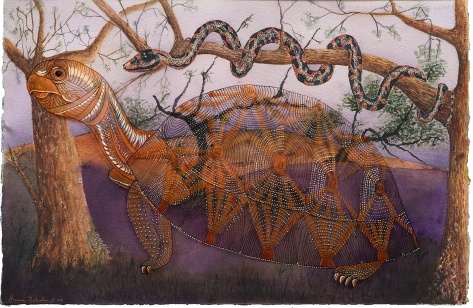
We are please to introduce Evanston artist and retired corporate consultant Lorna Galich as the next to be featured in our ongoing exhibition series Local Art @ EPL. Her show – which is dedicated to the memory of her daughter and EPL librarian Gigi Galich – is currently on display on the 2nd floor of EPL’s Main Library where you can catch it through August 31st. Featuring stunning watercolors, colored pencil drawings, and multi-layered portrayals of animals, her exhibit conveys her fascination with “all things natural, most particularly wild life.” Don’t miss this impressive show, and make sure to check back with Off the Shelf later in August for a featured interview with the artist herself. Stay tuned.
Trees of Knowledge
March 26, 2010
Yesterday I happened to read the editor’s introduction to the latest issue of Orion magazine. Orion is generally considered to be a “nature” magazine, and is usually shelved with similar titles at most newsstands and bookstores. But as the editor points out, Orion never intended to be viewed as any particular genre or fill any specialized niche within the magazine market. From Orion’s point of view, any writing anywhere that anyone is doing is in a sense “nature” writing. Since we all live in the natural world, any writing about people or place is in a way, writing about nature. Continue reading “Trees of Knowledge”
Have You Read . . . ?
September 18, 2009
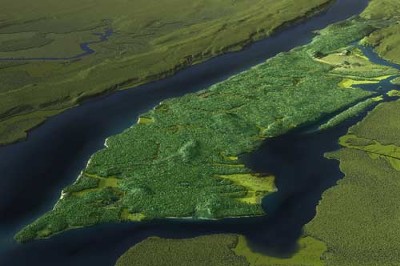
If the lush green island above looks strangely familiar, that’s because you’ve undoubtedly seen it many times before. Although if you’re having trouble placing just how you know this beautiful wild landscape, that’s because you’re probably used to seeing it look more like this:

Of course you know that the second picture is Manhattan Island as it looks today, the bustling hub of New York City. But the first picture above is the same island, Mannahatta or “Island of Many Hills,” (as it was called by local Native Americans) circa 1609.
For the past ten years the scientific researchers at the Mannahatta Project have been painstakingly recreating what the island would have looked like prior to the arrival of Henry Hudson and his crew on September 12, 1609. When the New World came calling, the island of Mannahatta was an amazingly diverse and abundant natural landscape, with more ecological communities, plant species, and birds than today’s Yellowstone, Yosemite, and Great Smoky Mountains National Parks. In addition to housing numerous large mammals, fish, and other wildlife, the island was also home to the Lenape tribe of people. In the 400 years since Hudson’s arrival, Mannahatta gave way to Manhattan, cultural diversity replaced biodiversity, and economic wealth replaced ecological wealth as the land that once existed was rendered virtually unrecognizable. Until now, that is. Over the past decade, the Mannahatta Project has been digitally rebuilding the land of yesterday by analyzing soil records, geography, rivers and wetlands, maps, descriptions of long disappeared plant and animal life, as well as by studying the landscape of the island today. The project is extensive in its research and astounding in its results.
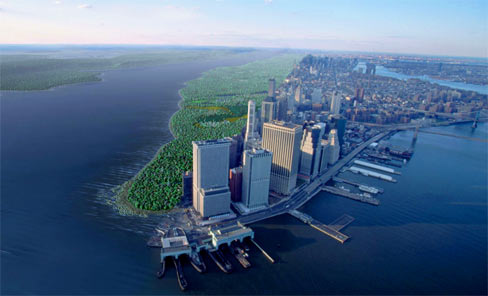
You can explore the island past and present in extensive detail in the new book Mannahatta: a Natural History of New York City. Inside you’ll find a full explanation of the science behind the project, detailed descriptions of just what the researchers discovered about the island, and a look forward to what Manhattan might look like 400 years from now. All of this is accompanied by numerous stunning illustrations of what the researchers believe Mannahatta to have looked like long ago, as well as amazing side by side comparisons of various spots around the city as they look now and how they would have appeared in 1609.
And for a more distilled and interactive look at the project, check out the very cool Mannahatta Project website. As the project researchers believe, by looking backwards into the past, perhaps we can glimpse a new ecological vision for the future.

